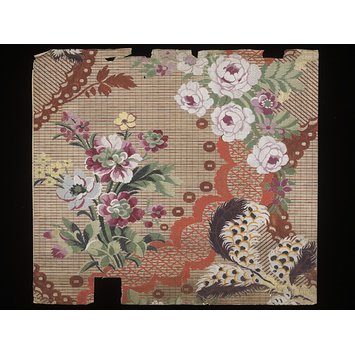Iris Moon is a visiting assistant professor in the School of Architecture at the Pratt Institute, New York. She discovered Joubert while doing research on the Lyon silk industry for a new project on luxury during the French Revolution. She was happy to have the chance to discuss his book with specialists in textiles at the Courtauld Institute conference, where she learned much about the complexities of weaving and designing silks in the eighteenth century.
Who read Le Dessinateur, pour les fabriques d’étoffes d’or, d’argent, et de soie, a manual on silk design written by Joubert de l’Hiberderie in 1765? This is not a question I began with when I initiated research on my presentation for the Courtauld’s conference, “Fabrications: Designing for Silk in the Eighteenth Century.” At first, the plan was to stick to my chosen topic: the usage of botany in Lyon silks of the mid to late-eighteenth century. Yet upon opening the pages of Joubert’s intimate octavo-size book, the question of readership repeatedly resurfaced. Who would have the time to peruse this text, especially in the difficult world of Lyon silk production, where weavers, drawgirls, and liseuses (the women responsible for calling out designs) had to pay such careful attention to thread counts and colour shifts in warp and weft? The technical aspects of silk design in Le Dessinateur would have likely been familiar to many of these laborers. Yet Joubert continually digresses into other topics, whether it is botany or the marvelous little nothings in Paris he repeatedly encourages young designers-in-training to see. He also plants personal confessions within the text. For example, in chapter 14, a section dedicated for the most part to watered silks, he writes that just as other silk designers betray a penchant for certain flowers in their fabric designs, he too has a favorite: “I have a weakness, I confess, for the rose: it has a sort of power over my brush, its form seduces me; its color imposes itself upon me; and as the queen of flowers, it captivates me.” Joubert writes that there isn’t a flower under the sun that he has not deftly represented in a silk pattern. Yet time and again he, “always returned to the rose; there is no flower with a happier form that, in my opinion, succeeds better.”1 In adopting an intimate confessional tone that draws attention to the rose as his preferred subject matter, Joubert reveals that fabric designs were not only determined by the demand of cosmopolitan fashion consumers and merchants in Paris, nor the heavily policed world of production in Lyon’s Grande Fabrique. They could also be about choice and possibilities. I am still not sure who might have read this book 250 years ago. But I’d like to imagine someone pausing from work to steal away with Le Dessinateur, and afterwards, stopping to study the roses in a completely new way.

1 Joubert de l’Hiberderie, Chapter XIV, 67. “Chaque Dessinateur a un penchant particulier, & cela sans s’en appercevoir, pour quelques fleurs qu’il répéte plus souvent que d’autres dans ses desseins. J’ai un foible, je l’avoue, pour la rose; elle a une sorte d’ascendant sur mon pinceau; sa forme me séduit; son coloris m’en impose; & comme la Reine des fleurs, elle me captive. Je l’ai employée très souvent avec succès; je trouve qu’elle se marie admirablement bien avec le jasmin; & dans toutes mes étoffes, on trouvera des roses & des jasmins pour base de tous mes desseins. Il n’est point de fleur dans la Nature, que tour-à-tour je n’aye cherché à représenter sur l’étoffe; & j’en suis toujours revenu à la rose; il n’est point de fleur d’une forme plus heureuse, & qui, selon moi, réuississe mieux.”




Your knowledge of the industry and instructions of your projects are the best around. Thank you..
Brother Eembroidery Machines
I am so excited i found you.It is very informative information. Thank you
It is very informative information. Thank youfor more information can read from news site named: fashion news
Great design